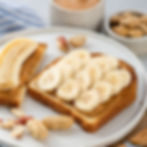Bananas & Type 1 Diabetes: Learn How To Reduce Blood Sugar Impact From Bananas
- Amanda Ciprich, MS, RD
- Apr 15, 2022
- 3 min read
*Disclaimer: This article is not intended to provide medical advice, diagnosis, opinion, treatment or services. This blog is meant to provide general information for educational purposes only. The information provided in this blog is not a substitute for medical care and should not replace advice from your healthcare provider.*

When living with type 1 diabetes, it is important to be aware of the nutrition content of the foods that you are eating. While fruits contain a wide variety of vitamins and minerals, they also contain carbohydrates that can contribute to blood sugar fluctuations. Bananas, in particular, have gained a bad reputation within the diabetes community due to their high sugar content, but there are a number of factors to consider before removing them from your diet. In this blog post, we are going to take a closer look at the different components that may be contributing to blood sugar rises and strategies you can utilize to reduce the blood sugar impact.

Be Mindful of The Size
When you choose a smaller size banana, you are also choosing a smaller amount of carbohydrates that will get converted into glucose and raise your blood sugar levels. Bringing awareness to the size of the banana you choose can help you be more accurate with your carb count. The carb count for bananas can range from 15g for a small banana to 35g for a large banana. Using the appropriate carb count for a banana can be helpful with keeping your blood sugars in range. If you need assistance with carb counting for bananas, a food scale can be beneficial in making sure you have the most accurate carbohydrate count for the banana you choose to enjoy.

Be Aware of the Bananas Ripeness
Green bananas typically have more resistant starch and lower amounts of sugar than yellow or yellow-brown bananas. Resistant starch supports glucose levels as it passes through the digestive tract unchanged instead of getting broken down into glucose. As bananas begin to ripen, the sugar quantity will change as the resistant starch gets converted into natural sugars.
This doesn’t mean people with diabetes should only eat green bananas, but to be able to utilize other nutrition or dosing strategies when choosing ripened bananas to offset any prominent rise in blood sugar levels.

Eat with a Banana with Protein and Fat
When you eat a banana alone, it will get digested a lot quicker than when you eat a banana along with protein and fat. Protein and fat slow down digestion of carbohydrates making the impact on blood sugar level less prominent. Some examples of protein and fat options to eat along with bananas include:
Nuts (almonds, walnuts, pecans, peanuts)
Seeds (pumpkin, sunflower, hemp, chia)
Cheese
Greek yogurt
Kefir
Cottage cheese
With a meal

Utilize A Prebolus
Whenever possible, you should be utilizing a prebolus when taking your insulin. A prebolus will give your body an opportunity to start absorbing insulin so that it is available when you start eating. If you find that your blood sugar is spiking after eating, you may need to increase your insulin timing earlier and if you are dropping you may need to prebolus a bit less. Prebolus timing is completely individual and multi-factorial so it may take some trial and error to find the appropriate timing to reduce blood sugar rises after eating. Be sure to connect with your healthcare providers to help fine tune your approach.
If you have type 1 diabetes, eating fruit can sometimes be worrisome due to the carbohydrate content and potential for blood sugar rises. However, fruit is still an important part of a healthy diet and provides your body with vitamins and minerals for your overall health. If you found this blog post helpful and want to learn more skills and strategies to manage your blood sugars without giving up foods that you love, check out Eating Essentials for Type 1 Diabetes: a self-paced course that will guide you on becoming an expert on nutrition and dosing strategies to effectively manage your blood sugar levels.

